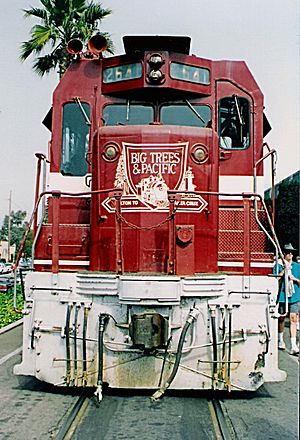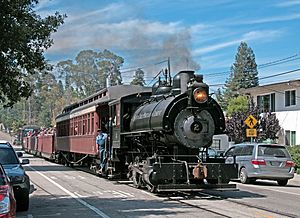Santa Cruz, Big Trees and Pacific Railway facts for kids
Quick facts for kids Santa Cruz, Big Trees and Pacific Railway |
|
|---|---|
 |
|

Santa Cruz, Big Trees and Pacific Railway #2641 stops at the Santa Cruz Beach Boardwalk in the summer of 1993.
|
|
| Locale | Santa Cruz County, California, USA |
| Commercial operations | |
| Built by | Santa Cruz and Felton Railroad |
| Original gauge | 3 ft (914 mm) converted to 4 ft 8 1⁄2 in (1,435 mm) |
| Preserved operations | |
| Reporting mark | SCBG |
| Preserved gauge | 4 ft 8 1⁄2 in (1,435 mm) |
| Commercial history | |
| Closed | 1981 |
| Preservation history | |
| 1985 | Started |
| Headquarters | Felton |
| Website | |
| roaringcamp.com/beachtrain.html | |
The Santa Cruz, Big Trees and Pacific Railway (SCBG) is a special kind of train line in Northern California. It carries both goods (freight) and people on fun trips. It's known as a "heritage railway" because it helps keep old train traditions alive.
This railway uses diesel trains to pull passenger cars. The journey is about 8 miles (13 km) long. It runs between Felton, California and the Santa Cruz Beach Boardwalk. Along the way, the tracks sometimes run right on the street! This is quite rare for trains in North America.
Train History: From Logs to Fun Rides
The railway started way back in 1875. It was first called the Santa Cruz and Felton Railroad. Its main job was to carry logs and lumber from the Santa Cruz Mountains. These materials went down to sawmills and docks on Monterey Bay.
In 1876, another railway, the South Pacific Coast Railroad, took over the Santa Cruz & Felton line. This connected Santa Cruz to a bigger train network. Later, in 1887, the Southern Pacific Railroad bought the line. They changed the tracks to a wider size, which is called "standard gauge."
Parts of the line closed in 1940 due to damage from floods. More damage in 1981 led to more closures. But then, a man named Norman Clark bought the line. He also ran the Roaring Camp & Big Trees Narrow Gauge Railroad. This railway was next to an 1880s-themed park in Felton.
The first train trip from Felton to Rincon on the reopened line happened in 1985. Sadly, Norman Clark passed away shortly before this. His daughter, Melani Jolley-Clark, now manages the company.
The trains start their journey at the Roaring Camp station in Felton. The original train station from 1880 is still there. It's now used as the company's main office. There's also an old freight shed. It was built from wood saved from a log flume. Today, it's used as a workshop for the railway.
Locomotives: The Engines That Pull the Trains
The Santa Cruz, Big Trees and Pacific Railway uses special diesel engines. They are called CF7 locomotives. These engines used to belong to the Atchison, Topeka and Santa Fe Railway. They were rebuilt to be more practical after passenger service ended.
The two main engines still have their original numbers: #2600 and #2641. In 2013, engine #2641 was named after Gene O'Lague. He was a long-time engineer for the Southern Pacific Railroad. He was also one of the first people to work at Roaring Camp.
Another diesel engine, number 20, was retired in 1996. Sometimes, an old steam engine called Santa Cruz-Portland Cement #2 has visited the railway. It was built in 1906. In 2018, the railway got two more CF7 engines, #2467 and #2524.
Images for kids




